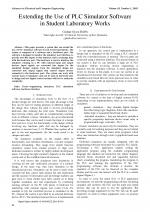| 1/2010 - 15 |
Extending the Use of PLC Simulator Software in Student Laboratory WorksHABA, C.-G. |
| Extra paper information in |
| Click to see author's profile in |
| Download PDF |
Author keywords
engineering education, PLC simulation software, hardware interface
References keywords
education(5)
No common words between the references section and the paper title.
About this article
Date of Publication: 2010-02-27
Volume 10, Issue 1, Year 2010, On page(s): 84 - 89
ISSN: 1582-7445, e-ISSN: 1844-7600
Digital Object Identifier: 10.4316/AECE.2010.01015
Web of Science Accession Number: 000275458900015
SCOPUS ID: 77954673545
Abstract
This paper presents a system that can extend the use of PLC simulator software in real world experiments. The system is composed of a software and a hardware part. The software is designed to monitor the simulator user interface, to provide user-like inputs to this interface and to exchange data with the hardware part. The hardware is used to interface the simulator running on a PC with external input and output devices. Input signals are converted into inputs for the simulated design; outputs from the simulated design are converted into output signals that control output devices connected to the hardware part. The system can work with various types of simulators and can be used in university labs to design and test digital control systems with low to moderate complexity. |
| References | | | Cited By «-- Click to see who has cited this paper |
| [1] Z. Kurmas, "Improving Student Performance Using Automated Testing of Simulated Digital Logic Circuits", Proceedings of ITiCSE'08, June 30-July 2 2008, Madrid, Spain, pp. 265-270, 2008
[2] D. A. Poplawski, "A pedagogically targeted logic design and simulation tool", In WCAE '07: Proceedings of the 2007 Workshop on Computer Architecture Education, pp. 1-7, 2007 [3] F. W. Bruns, Lernen in Mixed Reality, ABWF (Ed.): Kompetenzentwicklung 2003, Waxmann, Berlin, pp. 71-112, 2003 [4] EasyVeep - Handbuch/Manual, Festo Didactic GmbH & Co. KG, February, 2003 [5] C. Burch, "Logisim: a graphical system for logic circuit design and simulation", J. Educ. Resour. Comput. 2, pp. 5-16, 2002 [CrossRef] [SCOPUS Times Cited 73] [6] H. Dierks and J. Tapken, "Modelling and Verifying of 'Cash-Point Service' Using Moby/PLC", Formal Aspects of Computing, No. 12, pp. 222-221, 2000 [7] D. E. Clough, "The Missing Link in Process Control Education - Incorporating PLC's Into the ChE's Control Course", In Proceedings of the 2002 American Society for Engineering Education Annual Conference & Exposition, Montreal, Quebec, June 16-19 2002 [8] C. A. Chung, "A cost-effective approach for the development of an integrated PC-PLC-robot system for industrial engineering education", IEEE Transaction on Education, No. 41, pp. 306-310, 1998 [CrossRef] [SCOPUS Times Cited 13] [9] Alpha Simple Application Controller. Software Manual, Mitsubishi Electric Corporation, July 2002 [10] IEC 1131-3 Programmable Controllers - Part 3: Programming Languages, International Electrotechnical Commission, 1993 [11] Easy800 Steuerrelais, Bedienungshandbuch, Moeller GmbH, August, 2004 [12] User Manual of GMWIN version 4, LG Industrial Systems, January, 2000 [13] Internet TRiLOGI v.53. Programmer's Reference, Triangle Research International, Inc., 2003 Web of Science® Citations for all references: 0 SCOPUS® Citations for all references: 86 TCR Web of Science® Average Citations per reference: 0 SCOPUS® Average Citations per reference: 7 ACR TCR = Total Citations for References / ACR = Average Citations per Reference We introduced in 2010 - for the first time in scientific publishing, the term "References Weight", as a quantitative indication of the quality ... Read more Citations for references updated on 2025-07-01 01:16 in 16 seconds. Note1: Web of Science® is a registered trademark of Clarivate Analytics. Note2: SCOPUS® is a registered trademark of Elsevier B.V. Disclaimer: All queries to the respective databases were made by using the DOI record of every reference (where available). Due to technical problems beyond our control, the information is not always accurate. Please use the CrossRef link to visit the respective publisher site. |
Faculty of Electrical Engineering and Computer Science
Stefan cel Mare University of Suceava, Romania
All rights reserved: Advances in Electrical and Computer Engineering is a registered trademark of the Stefan cel Mare University of Suceava. No part of this publication may be reproduced, stored in a retrieval system, photocopied, recorded or archived, without the written permission from the Editor. When authors submit their papers for publication, they agree that the copyright for their article be transferred to the Faculty of Electrical Engineering and Computer Science, Stefan cel Mare University of Suceava, Romania, if and only if the articles are accepted for publication. The copyright covers the exclusive rights to reproduce and distribute the article, including reprints and translations.
Permission for other use: The copyright owner's consent does not extend to copying for general distribution, for promotion, for creating new works, or for resale. Specific written permission must be obtained from the Editor for such copying. Direct linking to files hosted on this website is strictly prohibited.
Disclaimer: Whilst every effort is made by the publishers and editorial board to see that no inaccurate or misleading data, opinions or statements appear in this journal, they wish to make it clear that all information and opinions formulated in the articles, as well as linguistic accuracy, are the sole responsibility of the author.



